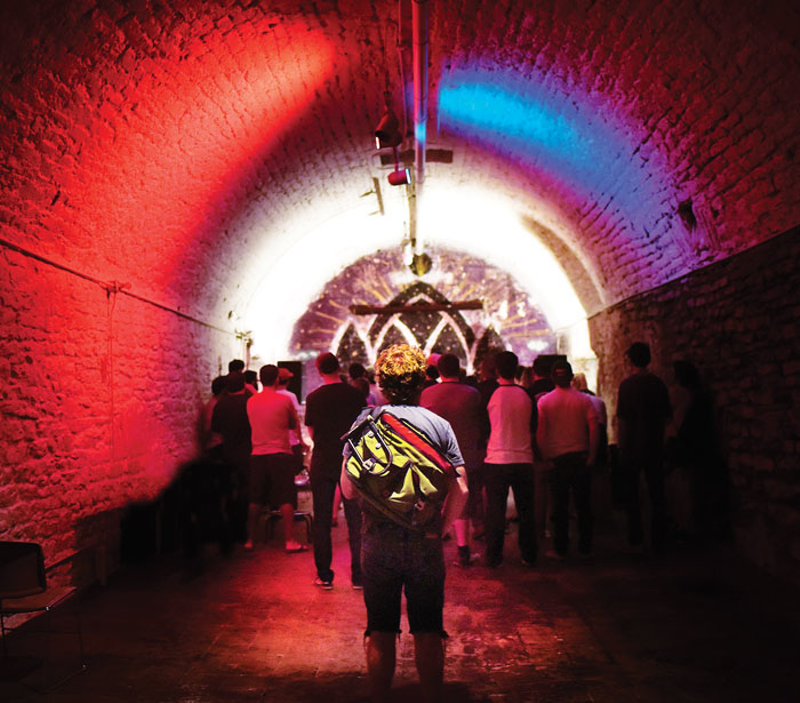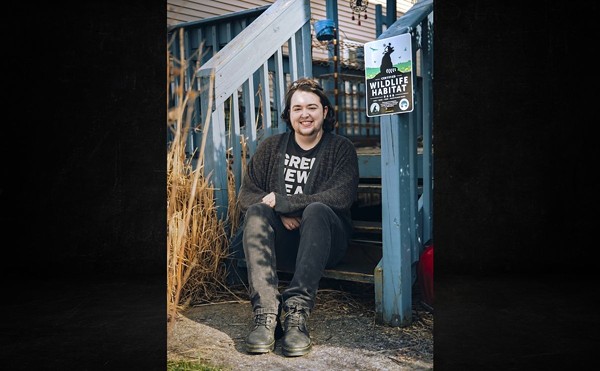When Cory Mangas and Jon Stevens bought the building known as the Mockbee on West McMicken Street in Brighton in November of 2015, it seemed like the next natural step for the two self-proclaimed “DIY developers.”
The two property owners already held the adjacent Art and Metal Co. building, which was once part of the Bellevue Brewing Company — a predecessor of Klotter and Sons Brewery, which dates back to 1866. The Mockbee was German immigrant Georg Friedrich Klotter’s second brewery, built in 1880.
As was common at the time, the building was set into the base of the hill, allowing brewers to take advantage of the natural geothermal cooling occurring in excavated tunnels — felsen in German — to produce and store their product without the use of artificial refrigeration.
The Reliance building that Mangas and Stevens bought last spring was, like the Mockbee, part of Klotter’s brewery complex. Those vast open spaces in the underbelly of this conversely hulking yet crumbling industrial space have served as inspiration for countless artists of every discipline for the better part of the past 15 years. This was largely the doing of several key stakeholders who took risks in trusting artists — prioritizing community building and accessibility over legalities and elitism.
By the time Mangas and Stevens bought the Mockbee last fall, the five-story building at the big bend on Central Parkway had sat largely vacant and unused for nearly three years, caught in a deadlock between the two previous owners, one of whom, Fred Lane, had owned the building since the early 2000s and is responsible for setting the precedent of the building as a hybrid residence/venue for artists.
Lane largely resists talking to the press, but his name and number is one that is exchanged freely among Punk kids, survivalists, gallery owners, urban renewal enthusiasts, motorcycle gang members, freelance contractors, recent graduates, addicts and artists alike.
A formerly Brighton-based landlord who offered affordable rent to people in the Mockbee as well as a handful of other buildings near the space for the better part of the past few decades, Lane agreed to be interviewed for this story because this writer has known him as both a tenant and an employer.
Lane has kept an article from The Cincinnati Enquirer above his desk for the past 22 years. Titled “Loft and Found,” the story covered then-mayor Roxanne Qualls’ push for a City Council vote to relax zoning and building codes to permit artists or others to legally live in loft spaces — encouraging the “recycling of the best old buildings by people who are able and willing to move in and fix them up, but have more sweat equity than cold cash.” And it was this discussion of Cincinnati’s “loft” living resources scattered throughout the city in places like Brighton, Over-the-Rhine and Northside that inspired the budding property developer to connect the dots between artists and real estate.
Likewise, Lane has rented buildings that were not always necessarily up to code — something he readily admits — as the spaces were often zoned for industrial use.
“It might not have been right with the city, but I didn’t do anything with the wrong heart trying to get over,” Lane says. “I just didn’t have the money to do everything right.”
Lane often lived in those same kinds of raw, under-developed spaces.
A Brighton resident for about 15 years, Lane says, “It would be unfair for me to set out in some suburb and collect rent.”
For further clarification, Lane offers the funny kind of misnomer he’s known for dropping: “I thought I should put my mouth where I lived.”
Lane’s big idea was to invest in the community in which he lived by buying up property and then generating money from those buildings, which would allow him to fix the buildings up.
So he allowed and encouraged tenants to build out the raw spaces to their unique needs. In return, and depending on Lane’s individual agreements with each renter, he charged rock bottom prices.
“He’s got kids living out here still for $200 a month,” says Mangas. “It’s crazy.”
In the late 1990s, Lane hung out at Kaldi’s, the local bastion for artists and creatives in Cincinnati at the time, and counted among his tenants the artist collective TODT and a veritable who’s-who list of (largely underpaid) local arts administrators. Lane owned the building that housed semantics gallery, for which he attests that over the course of 11 to 12 years as its landlord, he “never got a dime” from the volunteer-led artist-run space.
Lane approached one of his then-tenants in 2001, experienced curator and artist Emily Buddendeck, to be in charge of leading an arts venue in the bottom three floors of the Mockbee. Buddendeck was able to build upon the success of her gallery concept Sanctum Sanctorum, for which she had received an individual artist grant from the city that allowed her to exhibit themed shows in her various apartments around town as early as 1998.
Buddendeck changed the name of her curatorial/artistic endeavor to SSNOVA (Sanctum Sanctorum Nonprofit Organization and Venue for the Arts), set up a nonprofit, named a board and structured the organization to be open to all art forms — all while working for free.
Because the building was designed to be humid for storing beer/wine, shows had to be short, ephemeral, one-night events; otherwise the work could get ruined.
“The idea was all these different people would become familiar with the space and be more inclined to check out more art forms,” says Buddendeck, who is now the owner of NVISION vintage boutique in Northside. “It was a beautiful thing of cross pollination of disciplines and levels of abilities.”
Buddendeck ran the venue from 2001 to 2003, but working full time at the public library while putting on exhibitions and one-off shows twice a week for two years (and not being paid for it) wore on her.
Toward the end, the agreement between curator and building owner turned sour. Buddendeck moved on after securing a $35,000 grant from the city for an HVAC system to help rectify the humidity issue — part of which was later stolen off the side of the building. The new directors, blacksmith/metalwork artist Chris Daniel and Carissa Barnard, current deputy director of exhibitions and programming for FotoFocus, changed the name back to the Mockbee from SSNOVA.
But after they too left a few years later, the nonprofit status folded, but the name, which remains painted on the eastern side of the building, stuck.
During the mid-2000s, Lane leased space to a moped crew called The Bombardment Society, a branch of the national Moped Army, which occupied the space that now houses Able Projects at the Mockbee’s West McMicken streetside entrance. Able Projects, a skateboard-focused private screenprinting studio, has been one of the few ongoing tenants in the building since that time.
Lane owned the Queen Ann bar across the street on Central Avenue, then a known hangout for members of the Detroit-based outlaw motorcycle club, the Highwaymen. Members of TODT later changed the space into the Rake’s End bar currently in operation.
Lane also rehabbed and owned popular music venue/bar/restaurant the Gypsy Hut — now known as the Northside Yacht Club after a couple different owners and rehabbings — among various other underground entrepreneurial endeavors.
“I’m a warehouse worker 26 years riding a lift truck at Kroger,” Lane says more than a handful of times during our conversation. “I don’t have the money or talent to do it like (Mangas and Stevens) do.
“I never had any breaks when I was growing up,” he continues. “No money, nobody ever gave me anything cheap. So I saw people who — maybe that was their break.”
And as a caveat, Lane adds, “Sometimes under-the-table stuff is better for the city or community.”
According to Hamilton County Auditor transfer history records, testimony of those who lived in the building at the time and the word of the property owner himself, Lane sold the Mockbee to another developer in 2011 but concedes that he retained the note for the building. “I was the bank,” he says for clarification.
But a roof issue prompted the new owner to file an insurance claim, allowing a roofing company to come in. In a dispute between the insurance company and roofers over payment, the latter put a lien on the Mockbee, forcing an ensuing standoff between property owner and note holder.
So Lane sat for three years, waiting for his buyer to finally deal with the insurance company before he could foreclose on the property.
While he was waiting, Lane started running into Mangas and Stevens at Brewery District meetings.
The two developers grew up together in Defiance, Ohio, and have known each other since they were 8 years old.
Stevens moved to Cincinnati in the early ’90s for college, and Mangas followed about a decade ago to help one of their mutual friends renovate a building off of East McMicken and Liberty streets. Since 2009, the two have been slowly buying property — much of it in the Brewery District.
Taking cues from Lane, the two hired their booking, sound and bartending staff, many of which are one in the same, for the Mockbee from their pool of tenants and nearby Brighton neighbors.
Open to the public since February, this new iteration of the Mockbee is likewise interested in having local artists exhibit. The coordinator for such events, Megan Miller, is studio coordinator at Visionaries + Voices as well as a visual artist herself.
During their few months since opening, they’ve hosted open mic comedy hours, monthly meetings for the Cincinnati Preservation Collective, West End Community workshops, private brand launch parties and EDM dance parties. This past April, the Mockbee hosted the Contemporary Arts Center, which brought in Japanese sound and visual artist Tetsuya Umeda to perform in those hallowed tunnels.
The jury is still out on whether or not this group will be able to continue the storied history of the building as an incubator for local artistic communities.
Buddendeck, who was so successful in setting a high bar for the art that was shown there, talks about the spirit that encouraged her to accomplish so much in such a brief time. “DIY is not about space,” she says. “It doesn’t matter where it’s at — it could be in your own apartment. But that is crucial.
“DIY is an ethos that you carry with you.” she continues. “Having access/exposure to others’ examples of practice is crucial to awakening and feeding the can-do spirit within oneself.”
For more information about THE MOCKBEE in Brighton, including a schedule of upcoming shows and events, visit facebook.com/themockbee.






